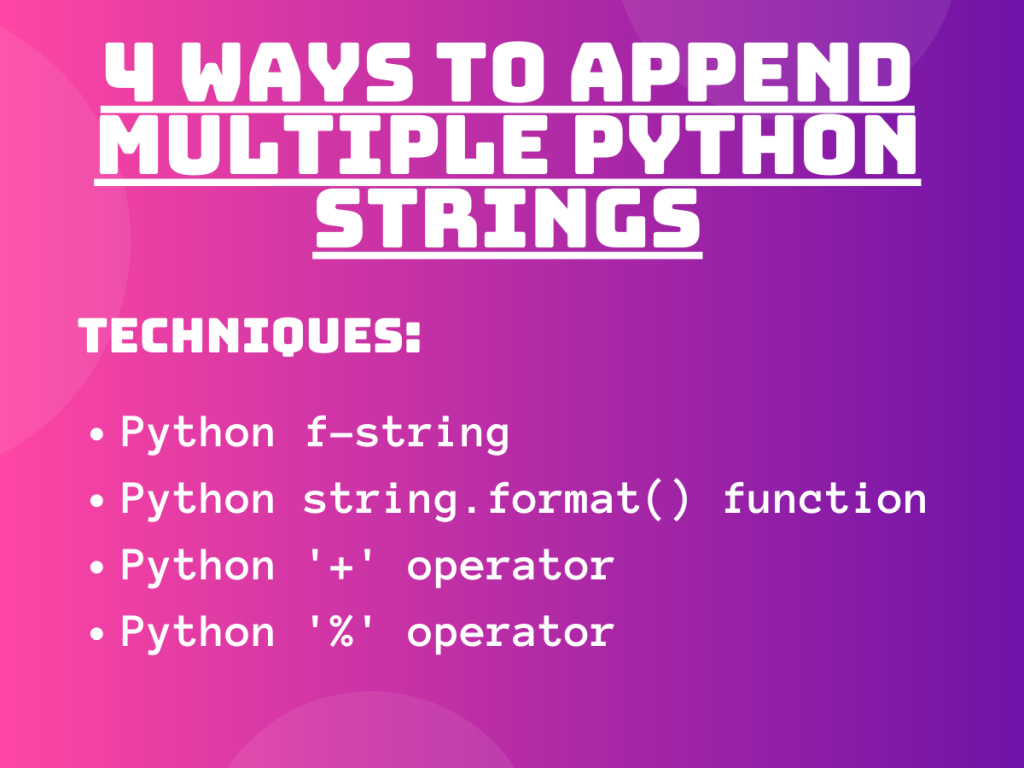In this article we will be having a look at the different ways to interpolate and append multiple strings in Python. String interpolation involves an injection of string in a particular statement. Let’s get right into it!
Technique 1: f-string to append multiple strings in Python
Python f-string is also known as format-strings have proved to be an efficient and optimal way to deal with strings. The f-string was introduced under the PEP 498 as Literal String Interpolation.
The f-string basically serves the purpose of string interpolation i.e. injection of multiple strings into a statement or structure.
Syntax:
f'{string1} {string2} {stringN}'
- {}: The string to be interpolated is placed between the curly braces.
Example 1:
str1 = 'Python'
str2 = '@'
str3 = 'JournalDev'
res = f'{str1} {str2} {str3}'
print("Appending multiple strings using f-string:\n")
print(res)
Output:
Appending multiple strings using f-string:
Python @ JournalDev
Example 2:
str1 = 'Python'
str2 = 'and'
str3 = 'R'
str4 = '@ JournalDev'
res = f'{str1} {str2} {str3} {str4}'
print("Appending multiple strings using f-string:\n")
print(res)
Output:
Appending multiple strings using f-string:
Python and R @ JournalDev
Technique 2: Python format() method to append multiple strings
Python string.format() function can also be used to format strings efficiently.
Syntax:
1. Single string formatting using format() function
{}.format(string)
2. Multiple string formatting using format() function
{} {}.format(string1, string2)
The string.format() function formats the strings and helps in the substitution of string through positional formatting i.e. according to the position of string placed in the function parameter list.
Example 1:
str1 = 'Python'
str2 = '@'
str3 = 'JournalDev'
res = "{} {} {}".format(str1, str2, str3)
print("Appending multiple strings using format():\n")
print(res)
Output:
Appending multiple strings using format():
Python @ JournalDev
Example 2:
str1 = 'Python'
str2 = 'and'
str3 = 'Java'
str4 = '@ JournalDev'
res = "{} {} {} {}".format(str1, str2, str3, str4)
print("Appending multiple strings using format():\n")
print(res)
Output:
Appending multiple strings using format():
Python and Java @ JournalDev
Let’s learn some more ways to append multiple strings in Python.
Technique 3: Using ‘+’ operator to append multiple strings
Python concatenation operator i.e. '+' operator can be used to append multiple strings together.
Syntax:
string1 + string2 + ..... + stringN
Example 1:
str1 = 'Python'
str2 = '@'
str3 = 'JournalDev'
res = str1 + str2 + str3
print("Appending multiple strings using Python '+' operator:\n")
print(res)
Output:
Appending multiple strings using Python '+' operator:
Python@JournalDev
Example 2:
str1 = 'Python'
str2 = '+'
str3 = 'R'
str4 = "@JournalDev"
res = str1 + str2 + str3 + str4
print("Appending multiple strings using Python '+' operator:\n")
print(res)
Output:
Appending multiple strings using Python '+' operator:
Python+R@JournalDev
Technique 4: Python ‘%’ operator to append multiple strings
Python '%' operator serves the purpose of string formatting and interpolation.
Syntax:
"%s" % (string)
The ‘%s’ serves as a placeholder to replace it with the string passed in the parenthesis ().
Example 1:
str1 = 'Python'
str2 = '+'
str3 = 'Java'
res = "%s %s %s" % (str1, str2, str3)
print("Appending multiple strings using Python '%' operator:\n")
print(res)
Output:
Appending multiple strings using Python '%' operator:
Python + Java
Example 2:
str1 = 'Python'
str2 = '+'
str3 = 'Java'
str4 = '@ journalDev'
res = "%s %s %s %s" % (str1, str2, str3, str4)
print("Appending multiple strings using Python '%' operator:\n")
print(res)
Output:
Appending multiple strings using Python '%' operator:
Python + Java @ journalDev
Conclusion
Thus, in this article, we have understood different ways to interpolate and append multiple strings in Python.
References
- Python String concatenation – JournalDev
